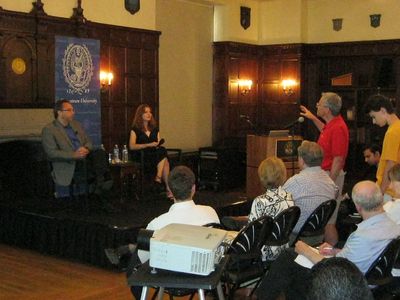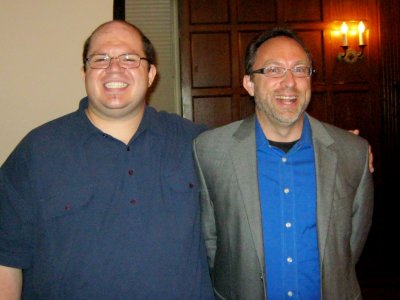More swimming, Jimbo Wales, and a new exercise guide!
8 minute read
June 13, 2011, 11:10 PM
Oh, do I have a lot to discuss today. First of all, I went swimming on Sunday, which was an interesting experience all its own. What made it so interesting was how busy the pool was. First, though, I got there early, while maintenance work was still going on. So I got to do something I’d told Mom I’d do for a while now: take pictures of the pool. And here they are:
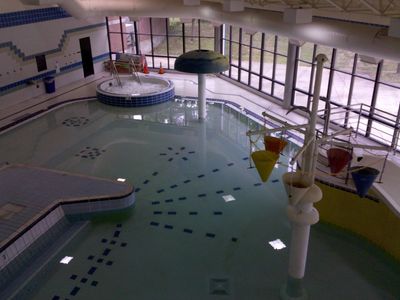
The “leisure pool” (read: kiddie pool) area. This pool is three feet deep at its deepest, and water is normally flowing out of the top of the mushroom structure towards the back, and water fills the buckets in the right of the photo. The buckets tip over and dump their contents when they become full. There’s also a small water slide that’s mostly out of frame, but you can see part of it behind the buckets. One of the two “hydrotherapy pools” (read: hot tub) is visible in the background.
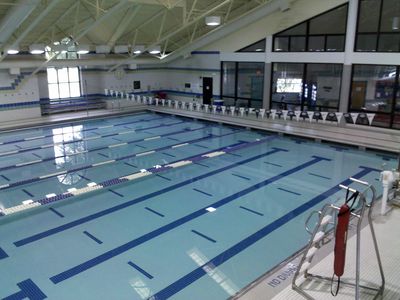
This is the main lap pool. It’s normally 25 meters long (the length can be adjusted), and can be divided into eight lap lanes. In my experience, the three lanes closest to the camera are normally not roped off into individual lanes during public lap swimming times, as shown here, though this is not always necessarily the case. In this case, the pool is set for five lanes for lap swimming, and three for people to play or do whatever in.
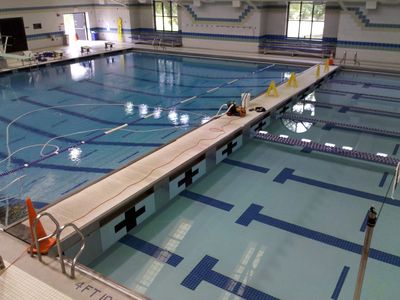
What I consider to be the most unique feature of Olney Swim Center is the bulkhead in the middle of the pool. Remember how I said that the length was adjustable? This is how that is accomplished. This bulkhead can be moved to any location along the pool, adjusting the sizes of the lap pool on one side, and the diving well on the other. I’m told that the bulkhead can’t be removed.
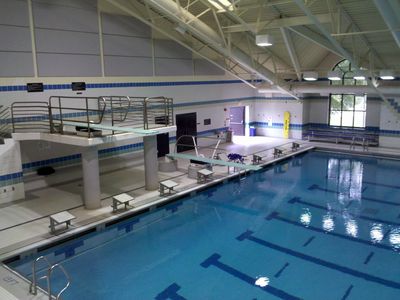
This is the diving well. The diving well is 13 feet deep, and then slopes back towards the lap area. The low dive is maybe four feet above the water, and then I’m told that the high dive is 13 feet above the water. And here’s an added bonus: the high dive doesn’t have one of those scary little ladders on it. This thing is equipped with real stairs leading up to it.
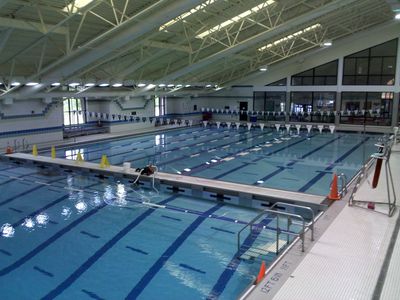
And here’s the whole thing looking back from near the diving boards.
Then once the pool opened for the afternoon rec swim (“rec swim” meaning that everything is open), I got going. I did my usual hour’s workout, broken into ten minute blocks. This time, the first block was kicking with a kickboard, the second block was breaststroke, the third block was front crawl, the fourth block was backstroke, the fifth block was a second round of front crawl, and lastly, the sixth block was another kicking session with the board. I used to do a breaststroke kick with the board in the second block, but dropped it because I don’t feel like I get enough out of it, i.e. after the warmup, I feel like I’m losing some momentum and then have to ramp it back up.
Then my lane must have had a revolving door on it or something. I think I had at least eight different swimming partners over the course of an hour. I started by myself, and then various people joined and left. It went from one to two to three to two to three to two to one to two to three to two to a different two and then finally one. Most interesting was a lady who was really swimming slowly. I’m not a particularly fast swimmer, but this lady was really slow while there were three people in my lane. Thus we had to manage traffic a little. It’s just like a two-lane road. With one person you do whatever you want. With two people, proper etiquette dictates that one person swim back and forth on one side of the lane, and the other person does the same on their side. For three or more, you swim in a circle and stay to the right. With the slow lady in the lane, there was some waiting, when the third swimmer was going the opposite direction, and I couldn’t pass until he was out of the way. Then one time, I accidentally backstroked into the slow lady. I’m just going, and all of a sudden, I start striking a body. Oops. I apologized for that, and was a little embarrassed about just plowing into someone like that. Thankfully, the lady understood that it was an accident, and was really nice about it.
I’m told that all the lanes were like mine, with swimmers coming and going at a pretty rapid pace. Hopefully there weren’t any other collisions, though.
After my hour of lap swimming, I headed over to the diving well. Workout before play, after all, and the diving well is fun. I kind of alternated over the course of the second hour between the low and high dives, and generally had a blast. I enjoy the diving boards, and it’s more exercise, though of a different variety after I’m done with my main workout. I first used the high dive last Friday, and it took a little bit of snapping, clapping, and chuckling to get me off the high dive for the first time, but eventually, I made it. Realize that it had been more than a decade since the last time I did a high dive. So I had to build up some courage to go. But I managed. The thing you don’t want to do is to look at the markings at the poolside for the depth of the pool, and then look down and think about all the distance between where you are and where the measurement that you read starts. That’s not a good thing to do. But I still jumped, and it was pretty fun. One of these days, I’m going to get a friend to photograph me using the diving boards for Life and Times. That should be fun to do.
Then otherwise, on Monday, I went to an event at Georgetown University after work. Wikipedia founder Jimbo Wales was speaking at Georgetown along with CiviliNation president Andrea Weckerle. The topic was civility online, and the biggest thing that I took from that was that people are much better behaved when they use their real-life identity online, vs. being a string of numbers or a pseudonymous name, where you could be anyone. I’ve always used my real name online from my earliest days on the Internet, and I like to think that it’s made me stop and think before I post something unkind, because I am posting as myself. I am not 123.456.789.000 or “ThatGuyWithABaldSpot” or something.
After the main event, Jimbo and Andrea held a question-and-answer session. That looked like this:
That was interesting, as many people got to ask Jimbo questions about various things, a lot related to Wikipedia. A few folks from the regular DC meetup group came to this as well.
And then after that, I got to say hello to Jimbo. And here we are:
I’d been wanting to meet Jimbo for a while, and so this was really neat to finally get to do that. It was kind of like meeting a celebrity.
Then on the way back to the Metro, I walked with a fellow DC Wikipedian back to Rosslyn station. That was a somewhat circuitous walk, as we went around to the bottom of the Georgetown campus, then back east a little bit, and down the Exorcist Steps:
Then from there, we went across the Key Bridge and over to Rosslyn station. Not bad.
While I was on the Metro heading back to Glenmont, I got ready to do my exercising for the day (as if the walk from Georgetown wasn’t enough). A friend recently sent me a really nice heart monitor, and with the weather having cooled off enough to where I could go walking, I took it out for a spin this evening on the walk home. So imagine this: I’m sitting in the seat on Alstom 6086, lifting up my shirt slightly (four inches?) to wrap the heart monitor around my middle, putting my shirt back down, and then sliding the heart monitor up to where it’s supposed to be. Then I strapped the receiver onto my left wrist. That looked funny, because it looked like I was wearing two different wristwatches, with one on each arm. Then when I got to Glenmont, I put my walking shoes on (yes, the toe shoes), and got going. I didn’t get the heart rate going as high as I had expected. On one of the uphill sections on Georgia Avenue, I peaked at 115 beats per minute. Then on my street, where there’s another uphill section, I got up to 120 beats per minute. On the long downhill section of Georgia Avenue, my heart rate was around 97 or so. My doctor says that I need to get it up to 150 beats per minute, so I have my work cut out for me, but at least now I know where I am and what I need to work on.
However, before I come up with a plan to step it up, I need to give myself a few more trials. This walk was unusual in a few ways. First of all, it was dark, and I was being more cautious on account of the reduced visibility. Second, the balls of my feet were a little sore from doing the earlier walk from Georgetown entirely in flip flops, which wasn’t the best idea in the world. I could have changed into my walking shoes before leaving Georgetown, after all, but that’s what I get for not thinking about these sorts of things. And lastly, there was some construction on the sidewalk in two places, that required me to stop, wait for a break in traffic, and then walk about 15-20 feet on the roadway to get around the construction areas before going back onto the sidewalk (where I belong). These construction zones went up while there were heat advisories (during which I did more swimming instead of walking), and so I still had to check them out to see if I could pass them. One looked passable, but on the other, they had it blocked off fairly well. So until these two construction zones disappear, I’m going to walk on the southbound side, which has less gravel than northbound, but has more glass.
So once I get a few more trials under my belt, then I look to figure out how to ramp this workout up a notch and work my way up to 150. But I am definitely going to be wearing the heart monitor for every walking session from now on. That is a really valuable piece of equipment that provides me with real-time feedback on my progress.
Web site: "WikiProject Shave the Wales", which imagines Jimbo Wales without a beard.
Song: Jimbo talks about Wikipedia's tenth anniversary, which happened this past January.
Quote: Funny, too - that heart monitor knows a lot about me. In setting it up, it asked for my height, weight, sex, and date of birth. It's not fooling around.
Categories: Olney, Recreation/Exercise, Washington DC, Wikipedia










